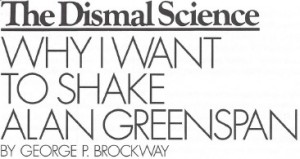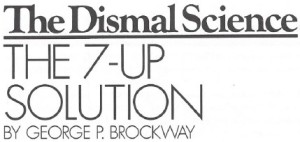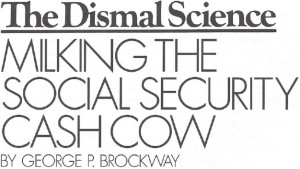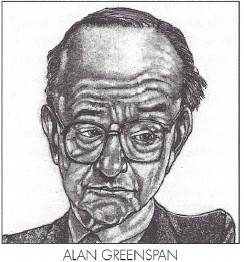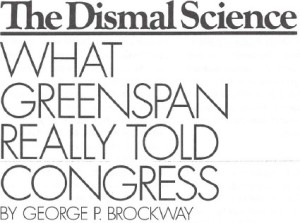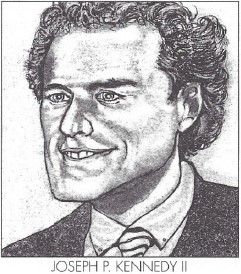By George P. Brockway, originally published July/August 2000
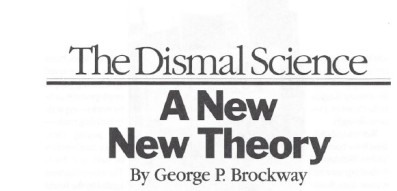 TWO YEARS AGO, the hope was expressed here that the Federal Reserve Board was on the verge of learning how a modem capitalist economy-call it “the New Economy” if you wish-actually works, or could work (“A Fortunate Experiment,” NL, August 10-24, 1998). But it has become clear that the Reserve was merely adopting another new theory of how a quasi-mercantilist economy functions at least the fifth in Chairman Alan Greenspan‘s incumbency.
TWO YEARS AGO, the hope was expressed here that the Federal Reserve Board was on the verge of learning how a modem capitalist economy-call it “the New Economy” if you wish-actually works, or could work (“A Fortunate Experiment,” NL, August 10-24, 1998). But it has become clear that the Reserve was merely adopting another new theory of how a quasi-mercantilist economy functions at least the fifth in Chairman Alan Greenspan‘s incumbency.
The previous new theory of the old economy went like this: Exuberant stock markets are giving rise to a “wealth effect,” whereby wildly successful speculators are using their inflated capital gains as collateral for loans to buy second (or first) homes and automobiles and a variety of other items, some necessary and some simply nice to have. As a result, the economy is in danger of “overheating.”
Now here comes what they call in Silicon Valley the new new thing: The secret cause of our trouble is that our productivity is growing too fast (the year before last it was supposed to be growing too slowly); consequently, the wealth effect is higher than ever. Indeed, it is so great that people’s income from borrowing on their capital gains exceeds their income from working at productive jobs. This situation is said to be unbalanced and unsustainable. We are borrowing on the future,” “living beyond our means,” and violating other 18th century copybook maxims.
Yet that is exactly the virtue of modern capitalism. It is how the company I worked for could expand to give me a better job, how my wife and I could buy a decent home in which to raise our children, how the city could build schools to educate them, and not least, how World War II could be won.
It is also argued that the wealth effect will cause too much money to chase after too few goods, a.k.a. inflation. A moderately rational person might consider encouraging the production of more goods wiser in such circumstances than reducing the amount of available money. The answer to this suggestion is that to produce more goods we would have to hire more people; and since we pride ourselves on having practically full employment (so why not say it’s really full?), we can’t hire more people without starting a wage-price spiral. To be sure, we have some 20 million fellow citizens who are either unemployed, underemployed, uninterested in employment at the going wage, or turned off.
Because of (not in spite of) the Federal Reserve Board’s threat to resume increasing the Federal funds rate, the United States economy is on the launching pad for an interest-price spiral (not a wage-price spiral) that could start spinning tightly upward before the 2000 election and then, before the election of 2004, could collapse in the ninth recession since the end of World War II.
In It Can’t Happen Here Sinclair Lewis’ hero opined that we Americans might one day have fascism but would call it antifascism. True to this heritage, the Federal Reserve Board has adopted an inflationary policy but tells us (and itself) that it is fighting an inflation invisible to ordinary folk like us because it is around the curve.
PERHAPS not altogether coincidentally, the Reserve acted in the same way almost a third of a century ago, in 1969, the last year we had a budget surplus before the current one. It was also the final year of what is now the economy’s second longest expansion. During the following 14 years we had four recessions, the highest unemployment rates since the Great Depression, a series of sensational bankruptcies, and a record breaking 271.4 per cent surge in the Consumer Price Index. The Reserve was serious about inflation the whole time.
Of course, there was a war on in Vietnam then and (as at present) trouble with the Organization of Petroleum Exporting Countries, but raising the interest rate did not stop the war and in truth started the trouble with OPEC. Meanwhile, the costs of living and doing business went higher, and the budget surplus was wiped out.
Money has power-several powers, in fact, as we shall see. The most familiar is its purchasing power. The Federal Reserve Board, in its diurnal struggle with inflation, has long concentrated on restraining money’s buying power. It does this by increasing the interest rate in order to reduce the number of consumers able to buy interest-sensitive commodities (especially cars and houses). This, in turn, reduces the number of workers employed in supplying those commodities, keeping them from buying other commodities they want or need. All of that is supposed to prevent the economy from overheating.
When we return from a shopping (or web-surfing) expedition and say the dollar doesn’t go as far as it used to, we mean its purchasing power is reduced. That is the same as a rise in the general price level, which is the same-as inflation.
THERE ARE two other probable, but presumably unintended, consequences of the Reserve’s actions. The first is a recession. To rephrase “Engine Charlie” Wilson, what is bad for General Motors is bad for the economy. We can’t slow down on the building trades and the automobile industry and their many auxiliaries (steel, lumber, oil, glass, rubber, major appliances, and on and on) without slowing down the whole show. Second, although the Reserve may have only restraint of purchasing power in mind, raising the interest rate simultaneously reduces the borrowing and investing power of money.
A fall in the investing power of money is, of course, the same as a decline in the amount of investing that is done-in other words, stagnation. Assuming that a projected investment is attractive and that the credit of the company wanting to make it is sound, the interest rate determines the limit of investing the company can finance with a given sum.
The range of impacts on investing power is vast, as four historical examples will show. Before the 1951 “Accord” that “freed” the Federal Reserve Board from its World War II commitment to help the Treasury maintain the market prices (and, of course, the interest rates) of government securities (not an unreasonable chore for a central bank in time of war or peace), the prime rate was 1.5 per cent. In December 1980 and January 1981 the prime topped off at 21.5 percent. In June 1999, at the start of the Reserve’s present program, it stood at 7.75 percent. Now it has reached 9.5 per cent (not so long ago, anything over 6 per cent was illegal usury). A corporation that could afford an annual interest expense of $150,000 and borrow at prime, could therefore have borrowed and invested $10 million in the first example, but only $697,674 in the second example, $1,935,484 a year ago, and $1,598,947 today.
Moreover, the effects of a rise (or fall) in the interest rate multiply throughout the economy. When the prime hit 21.5 per cent around Christmastime 1980 and our company’s investment was limited to $697,674, the purchasing power of every dollar of that amount likewise fell 12 per cent. So the firm could actually purchase only $613,953 worth of goods and services for its investment.
The Reserve’s present program (ironically assisted by OPEC) will increase the cost of doing business and will soon prompt or excuse enough price increases to embolden the many inflation hawks on its Board of Governors to push harder for really pre-emptive strikes, whereupon further price increases will begin appearing on the visible part of the curve, and the interest-price spiral will be well launched.
The increasing prices will harden the inflation hawks’ belief that they “must” (as the business press puts it) raise the interest rate to hold prices down. But a capitalist economy is based on borrowing, and the causation runs from the cost of borrowing (the interest rate) to price, rather than the other way[1]. Every firm, before it starts work on a new project, or orders a new production run of an old one, must know its costs to set prices.
The cost of borrowing is established by the Federal Reserve Board when it determines the Federal funds rate. To be sure, that rate is the one banks charge each other for very short-term loans (usually overnight) to allow the borrowing bank to meet an emergency or to take advantage of an exceptional opportunity, but it also sets the floor under the cost of all borrowing.
Today the nation’s business enterprises routinely quote many millions of prices, change some, and establish thousands of new ones. Scores of millions of consumers agree to some of the prices, and sales are made; a few haggle for lower ones, with occasional success. All of these prices are based in part on what the Reserve did at its last meeting. But there is no way on earth that what the Reserve did at its last meeting could have been based on the prices sellers and buyers actually agree to afterward.
This is not a chicken–and–egg question. Actual prices are based on actual costs, never the other way around. Businesses do not set the floor under interest rates, the Federal Reserve does[2].
In sum, as the Federal Reserve Board continues to raise the interest rate, it will cause stagnation (a decline in investment), stimulate inflation (a rise in the price level), and achieve its perverse intentions (a decrease in demand and an increase in unemployment). It will prick the stock exchanges’ irrational bubbles with consequences that will confirm the wisdom of Marcel Proust, somewhere in whose expansive universe is the observation that our wishes may be fulfilled, on the condition that we not find in them the satisfactions we expected.
IT IS POSSIBLE that the Reserve is already too far in to back out, for to cut rates now would announce to all the Fed watchers that the threat of inflation was past. The bull market would roar ahead, speculators confident that the Reserve would protect them. (Economists call this phenomenon by the odd name of “moral hazard.”)
Yet at the very least stagnation would be avoided if the Reserve did the unimaginable and lowered rates. At the best, new ways might be found to expand the economy and to reverse the fatal trend toward continually widening the chasm between the haves and the have-nots of our society.
Given the Reserve’s blind tradition of “staying the course,” the summer’s growing inflation and stagnation may continue and prove enough to defeat Vice President Gore (as former Reserve Chairman
Paul A. Volcker‘s recession defeated Jimmy Carter 20 years ago). Similarly, 2004’s recession[3] may prove enough to defeat then-President Bush (as Chairman Greenspan’s recession defeated his father eight years ago).
The New Leader
[1] Ed: my emPHAsis
[2] Ibid
[3] Ed: Well, it happened in 2007
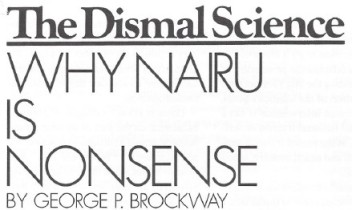
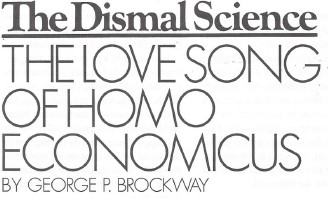
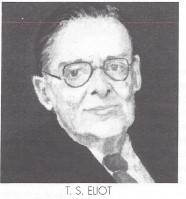 The wealthy are not the only ones contributing to this trend. The middle class is the beneficial owner, through what are called “institutions” (especially mutual funds and pension funds and insurance policies), of between one-third and one half of all the shares on the current exchanges. By being funded rather than treated as current expenses, these institutions soak up purchasing power and weaken aggregate demand. The funds’ speculating deprives
The wealthy are not the only ones contributing to this trend. The middle class is the beneficial owner, through what are called “institutions” (especially mutual funds and pension funds and insurance policies), of between one-third and one half of all the shares on the current exchanges. By being funded rather than treated as current expenses, these institutions soak up purchasing power and weaken aggregate demand. The funds’ speculating deprives 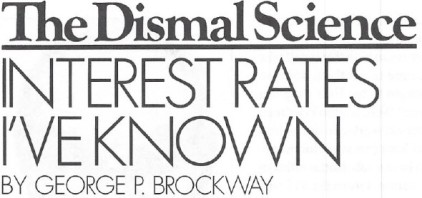 FRIENDS have been congratulating me on bringing
FRIENDS have been congratulating me on bringing  ONE OF THE mysteries of life in the United States today is why we are not in the midst of a raging inflation, a depressing recession, or both. The answer, though, is staring us in the face.
ONE OF THE mysteries of life in the United States today is why we are not in the midst of a raging inflation, a depressing recession, or both. The answer, though, is staring us in the face.